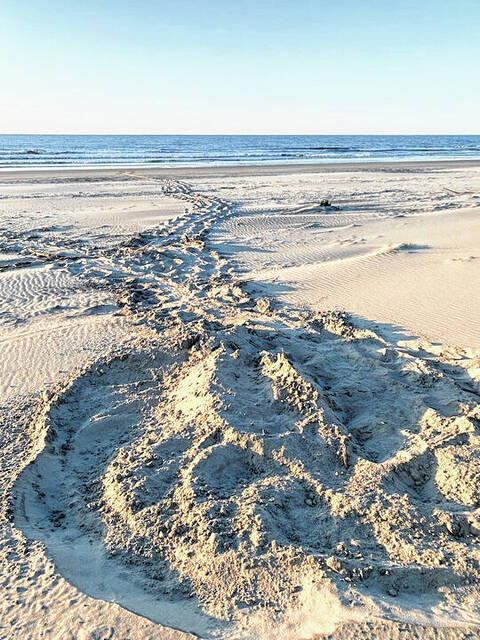
Sea turtle tracks lead to one of the first sea turtle nests of the season on South Island in Georgetown County. (Photo: Corinne Johnston/SCDNR)
SOUTH CAROLINA — The turtles are right on cue! Biologists counted South Carolina’s first two sea turtle nests of the season: S.C. Department of Natural Resources’ (SCDNR) Corinne Johnston found a loggerhead nest on South Island (part of Yawkey Wildlife Center) and Jerry Tupacz of the U.S. Fish and Wildlife Service found a loggerhead nest on North Cape Island (part of Cape Romain National Wildlife Refuge).
This is the second year in a row that South Carolina’s first sea turtle nest has appeared on May 2, one day after the ‘official’ start of the season. Both nests follow ‘false crawls’ spotted yesterday on each island, tracks indicating a female sea turtle had come ashore but ultimately did not lay eggs.
Cape Romain National Wildlife Refuge and Yawkey Wildlife Center are home to the densest nesting in South Carolina, but sea turtles lay their eggs on beaches across the coast. SCDNR staff rely on a network of over 1,500 trained volunteers to regularly patrol beaches from May 1 to October 31 to count, monitor and protect sea turtle nests.
The 2023 season opens on the heels of another record-breaking year: in 2022, biologists and volunteers counted 7,996 sea turtle nests in South Carolina, marking the second-highest year since record-keeping began. Prior to 2022, nest numbers held steady at 5,644 nests in 2021 and 5,560 in 2020.
Nesting requires a great deal of energy, so female sea turtles do not lay eggs every year. This cyclical pattern of nesting results in fluctuating nest numbers from year to year. It’s not unusual for record-breaking years (like 2019; 8,795 nests) to follow low nesting years (like 2018; 2,766). A robust winter diet is crucial for female sea turtles to recoup the energy and nutrient reserves needed for shelling and laying eggs.
Overall, sea turtle nest numbers across the Southeast have trended up over the past decade after several decades of conservation efforts.
“We’re optimistic, but nest numbers have not reached Loggerhead Recovery Plan benchmarks, and the species is not out of the woods just yet,” said SCDNR biologist Michelle Pate, who leads the agency’s sea turtle nesting and stranding program. “Long term monitoring of these long-lived species needs to continue to ensure current management continues to work.”
Four sea turtle species nest on South Carolina beaches: loggerheads, greens, Kemp’s ridleys, and leatherbacks. All four species are classified as endangered or threatened and are protected under the Endangered Species Act in addition to state law. Loggerhead nests comprise most of the state’s total number each year.
Sea turtle clutches average 120 eggs and hatch after approximately 60 days. Nesting females may remain in South Carolina waters and continue to nest every two weeks, laying up to six nests per season. Throughout this stressful time, the turtles also abstain from eating.
South Carolina beachgoers can help the state’s sea turtles by keeping beaches clean, turning beachfront lights out to avoid disorienting turtles, and giving all sea turtles and nests a wide and respectful berth when encountered on the beach.
Sea Turtle Nesting Season Reminders
Report all sick/injured/dead sea turtles and nest disturbances to the SCDNR at 1-800-922-5431 so that staff/volunteers can respond as soon as possible.
Respect boating laws and boat cautiously, especially in small tidal creeks where sea turtles like to feed. Boat strikes have emerged as the leading cause of death for sea turtles in South Carolina.
Keep artificial lights off the beach at night during nesting season – this includes beachfront property lights and flash photography, which can disorient nesting mothers and hatchlings.
Always respect sea turtles by observing them from a distance on the beach. Individuals that violate federal law by harming or interfering with sea turtles or their nests can be subject to civil penalties of up to $25,000 and up to a year’s imprisonment.
Keep our beaches and ocean clean by avoiding single-use plastics. Plastic bags and balloons are among the most common trash items found on South Carolina beaches and can cause injury or death when sea turtles mistake them for food.
Promote and support our program for continued conservation of sea turtles in South Carolina.

